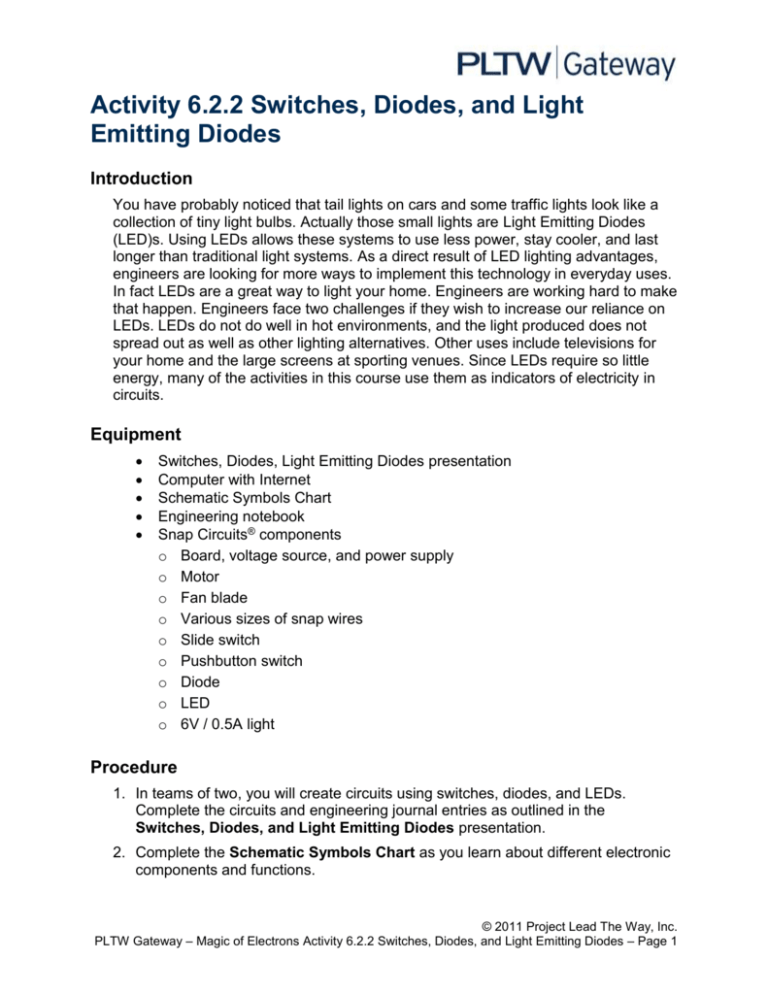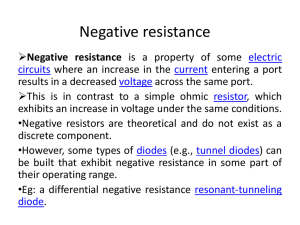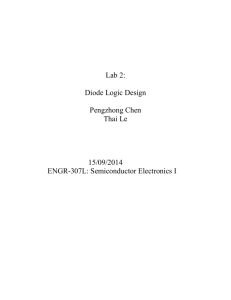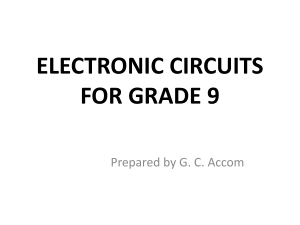Activity 6.2.2 Switches, Diodes, and Light Emitting Diodes Introduction
advertisement

Activity 6.2.2 Switches, Diodes, and Light Emitting Diodes Introduction You have probably noticed that tail lights on cars and some traffic lights look like a collection of tiny light bulbs. Actually those small lights are Light Emitting Diodes (LED)s. Using LEDs allows these systems to use less power, stay cooler, and last longer than traditional light systems. As a direct result of LED lighting advantages, engineers are looking for more ways to implement this technology in everyday uses. In fact LEDs are a great way to light your home. Engineers are working hard to make that happen. Engineers face two challenges if they wish to increase our reliance on LEDs. LEDs do not do well in hot environments, and the light produced does not spread out as well as other lighting alternatives. Other uses include televisions for your home and the large screens at sporting venues. Since LEDs require so little energy, many of the activities in this course use them as indicators of electricity in circuits. Equipment Switches, Diodes, Light Emitting Diodes presentation Computer with Internet Schematic Symbols Chart Engineering notebook Snap Circuits® components o Board, voltage source, and power supply o Motor o Fan blade o Various sizes of snap wires o Slide switch o Pushbutton switch o Diode o LED o 6V / 0.5A light Procedure 1. In teams of two, you will create circuits using switches, diodes, and LEDs. Complete the circuits and engineering journal entries as outlined in the Switches, Diodes, and Light Emitting Diodes presentation. 2. Complete the Schematic Symbols Chart as you learn about different electronic components and functions. © 2011 Project Lead The Way, Inc. PLTW Gateway – Magic of Electrons Activity 6.2.2 Switches, Diodes, and Light Emitting Diodes – Page 1 List and describe the four types of mechanical switches. 1. 2. 3. 4. In the space to the right, draw a schematic for a circuit that will power a lamp using a slide switch and a DC source. In the space to the right, draw a schematic for a circuit that will power a motor using a pushbutton switch and a DC source. What is the purpose of a diode? As we learned previously, both p-type and n-type doping of silicon conduct electricity. They just differ in HOW they conduct. However, when p-type silicon is formed in a chip with n-type silicon, electrons will flow through the silicon IN ONE DIRECTION. This is called the “THE PRINCIPLE OF THE DIODE”. Where these two types of silicon intersect is called THE PN JUNCTION. © 2011 Project Lead The Way, Inc. PLTW Gateway – Magic of Electrons Activity 6.2.2 Switches, Diodes, and Light Emitting Diodes – Page 2 How the Diode works - A diode is like a ONE-WAY VALVE for electricity. Current can only flow through it in one direction. Here’s a simplified explanation of how a diode conducts electricity in one direction (FORWARD) while blocking the flow of current in the opposite direction (REVERSE). Electron Flow No Current Flow Hole flow Here the charge from the Here the charge from the battery REPELS the electrons battery ATTRACTS holes and holes towards the PN towards the negative, and junction. If there is enough electrons towards the positive, voltage, the electrons will both AWAY from the junction. CROSS the junction and Therefore, no current can flow current will flow. Diodes are commonly enclosed in a small glass cylinder. A dark band marks the NEGATIVE terminal. The opposite terminal is the POSITIVE. There are many different types of diodes, which are used in many different applications. One type the RECTIFIER is used to convert AC power to DC power. In the space to the right, draw a schematic for a circuit that uses a DC source to power a lamp and includes a diode. An LED is a special kind of diode that lights and is used in a circuit to show that a © 2011 Project Lead The Way, Inc. PLTW Gateway – Magic of Electrons Activity 6.2.2 Switches, Diodes, and Light Emitting Diodes – Page 3 current is flowing. LED stands for LIGHT EMITTING DIODE. An LED sometimes has one leg SHORTER than the other. The shorter leg is NEGATIVE and the longer one is POSITIVE. The negative leg might also have a FLAT SIDE on the plastic cap to help you identify it. It is important to connect the LED’s legs the right way in a circuit (negative to negative, positive to positive). In the space to the right, draw a schematic for a circuit that uses a DC source that will power and LED and includes a diode. Describe or draw a diagram that shows the Conventional Current Flow Theory. Describe or draw a diagram that shows the Electron Flow Theory. © 2011 Project Lead The Way, Inc. PLTW Gateway – Magic of Electrons Activity 6.2.2 Switches, Diodes, and Light Emitting Diodes – Page 4 Using the schematics you drew of the pictures in the presentation, build the following circuits. Be sure to have your instructor sign your paper for confirmation. Lamp with slide switch: Circuit Construction ______________ Motor with push button switch: Circuit Construction ______________ Observations: 1. Turn the motor around in the circuit. What happens? 2. Does the motor have polarity (meaning, it HAS to be connected in the circuit in a specific way)? Diode with lamp circuit: Circuit Construction ______________ Observations: 1. Did the lamp turn on with the first try? 2. Turn the diode around. What happens? 3. Why? Diode with LED circuit: Circuit Construction ______________ Observations: 1. Did the LED turn on with the first try? 2. What happens if your turn the LED around in the circuit? 3. What happens if you turn the diode around in the circuit? 4. Explain what is happening in questions #2 and #3 above. 5. In math, multiplying two negatives makes a positive. Explain what happens if you turn both the LED and the diode around in the circuit. © 2011 Project Lead The Way, Inc. PLTW Gateway – Magic of Electrons Activity 6.2.2 Switches, Diodes, and Light Emitting Diodes – Page 5 Conclusion 1. Diodes can be used to protect electronic components from current flowing in another direction. Describe another application outside of electronics where it would be important for something to flow in only one direction. 2. Describe three objects in your house that utilize LEDs. 3. Use the Internet to research the use of LED systems to replace general household lighting. Describe one advantage and one disadvantage of replacing standard light bulbs with LED lighting. 4. What are the two ways to determine the negative leg of an LED? © 2011 Project Lead The Way, Inc. PLTW Gateway – Magic of Electrons Activity 6.2.2 Switches, Diodes, and Light Emitting Diodes – Page 6
![Semiconductor Theory and LEDs []](http://s2.studylib.net/store/data/005344282_1-002e940341a06a118163153cc1e4e06f-300x300.png)






